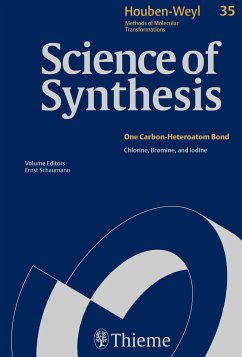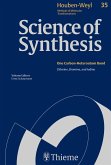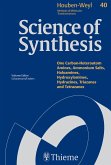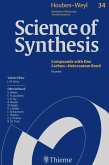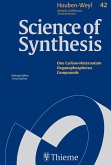Science of Synthesis: Houben-Weyl Methods of Molecular Transformations Vol. 35 (eBook, ePUB)
Chlorine, Bromine, and Iodine
2.199,99 €
inkl. MwSt.
Sofort per Download lieferbar

0 °P sammeln
Science of Synthesis: Houben-Weyl Methods of Molecular Transformations Vol. 35 (eBook, ePUB)
Chlorine, Bromine, and Iodine
- Format: ePub
- Merkliste
- Auf die Merkliste
- Bewerten Bewerten
- Teilen
- Produkt teilen
- Produkterinnerung
- Produkterinnerung

Bitte loggen Sie sich zunächst in Ihr Kundenkonto ein oder registrieren Sie sich bei
bücher.de, um das eBook-Abo tolino select nutzen zu können.
Hier können Sie sich einloggen
Hier können Sie sich einloggen
Sie sind bereits eingeloggt. Klicken Sie auf 2. tolino select Abo, um fortzufahren.

Bitte loggen Sie sich zunächst in Ihr Kundenkonto ein oder registrieren Sie sich bei bücher.de, um das eBook-Abo tolino select nutzen zu können.
Science of Synthesis: Houben-Weyl Methods of Molecular Transformations is the entirely new edition of the acclaimed reference series Houben-Weyl, the standard synthetic chemistry resource since 1909. This new edition is published in English and will comprise 48 volumes published between the years 2000 and 2008.
Science of Synthesis is a quality reference work developed by a highly esteemed editorial board to provide a comprehensive and critical selection of reliable organic and organometallic synthetic methods. This unique resource is designed to be the first point of reference when…mehr
- Geräte: eReader
- ohne Kopierschutz
- eBook Hilfe
- Größe: 25.92MB
- Upload möglich
Andere Kunden interessierten sich auch für
![Science of Synthesis: Houben-Weyl Methods of Molecular Transformations Vol. 35 (eBook, PDF) Science of Synthesis: Houben-Weyl Methods of Molecular Transformations Vol. 35 (eBook, PDF)]() Science of Synthesis: Houben-Weyl Methods of Molecular Transformations Vol. 35 (eBook, PDF)2.199,99 €
Science of Synthesis: Houben-Weyl Methods of Molecular Transformations Vol. 35 (eBook, PDF)2.199,99 €![Science of Synthesis: Houben-Weyl Methods of Molecular Transformations Vol. 37 (eBook, ePUB) Science of Synthesis: Houben-Weyl Methods of Molecular Transformations Vol. 37 (eBook, ePUB)]() Science of Synthesis: Houben-Weyl Methods of Molecular Transformations Vol. 37 (eBook, ePUB)2.589,99 €
Science of Synthesis: Houben-Weyl Methods of Molecular Transformations Vol. 37 (eBook, ePUB)2.589,99 €![Science of Synthesis: Houben-Weyl Methods of Molecular Transformations Vol. 41 (eBook, ePUB) Science of Synthesis: Houben-Weyl Methods of Molecular Transformations Vol. 41 (eBook, ePUB)]() Science of Synthesis: Houben-Weyl Methods of Molecular Transformations Vol. 41 (eBook, ePUB)2.589,99 €
Science of Synthesis: Houben-Weyl Methods of Molecular Transformations Vol. 41 (eBook, ePUB)2.589,99 €![Science of Synthesis: Houben-Weyl Methods of Molecular Transformations Vol. 40a (eBook, ePUB) Science of Synthesis: Houben-Weyl Methods of Molecular Transformations Vol. 40a (eBook, ePUB)]() Science of Synthesis: Houben-Weyl Methods of Molecular Transformations Vol. 40a (eBook, ePUB)2.589,99 €
Science of Synthesis: Houben-Weyl Methods of Molecular Transformations Vol. 40a (eBook, ePUB)2.589,99 €![Science of Synthesis: Houben-Weyl Methods of Molecular Transformations Vol. 34 (eBook, ePUB) Science of Synthesis: Houben-Weyl Methods of Molecular Transformations Vol. 34 (eBook, ePUB)]() Science of Synthesis: Houben-Weyl Methods of Molecular Transformations Vol. 34 (eBook, ePUB)2.199,99 €
Science of Synthesis: Houben-Weyl Methods of Molecular Transformations Vol. 34 (eBook, ePUB)2.199,99 €![Science of Synthesis: Houben-Weyl Methods of Molecular Transformations Vol. 39 (eBook, ePUB) Science of Synthesis: Houben-Weyl Methods of Molecular Transformations Vol. 39 (eBook, ePUB)]() Science of Synthesis: Houben-Weyl Methods of Molecular Transformations Vol. 39 (eBook, ePUB)2.399,99 €
Science of Synthesis: Houben-Weyl Methods of Molecular Transformations Vol. 39 (eBook, ePUB)2.399,99 €![Science of Synthesis: Houben-Weyl Methods of Molecular Transformations Vol. 42 (eBook, ePUB) Science of Synthesis: Houben-Weyl Methods of Molecular Transformations Vol. 42 (eBook, ePUB)]() Science of Synthesis: Houben-Weyl Methods of Molecular Transformations Vol. 42 (eBook, ePUB)2.589,99 €
Science of Synthesis: Houben-Weyl Methods of Molecular Transformations Vol. 42 (eBook, ePUB)2.589,99 €-
-
-
Science of Synthesis: Houben-Weyl Methods of Molecular Transformations is the entirely new edition of the acclaimed reference series Houben-Weyl, the standard synthetic chemistry resource since 1909. This new edition is published in English and will comprise 48 volumes published between the years 2000 and 2008.
Science of Synthesis is a quality reference work developed by a highly esteemed editorial board to provide a comprehensive and critical selection of reliable organic and organometallic synthetic methods. This unique resource is designed to be the first point of reference when searching for a synthesis strategy.
For full information on the Science of Synthesis series, visit the Science of Synthesis Homepage
Science of Synthesis is a quality reference work developed by a highly esteemed editorial board to provide a comprehensive and critical selection of reliable organic and organometallic synthetic methods. This unique resource is designed to be the first point of reference when searching for a synthesis strategy.
- Contains the expertise of presently 400 leading chemists worldwide
- Critically evaluates the preparative applicability and significance of the synthetic methods
- Discusses relevant background information and provides detailed experimental procedures
For full information on the Science of Synthesis series, visit the Science of Synthesis Homepage
Produktdetails
- Produktdetails
- Verlag: Thieme
- Erscheinungstermin: 14. Mai 2014
- Englisch
- ISBN-13: 9783131783110
- Artikelnr.: 40842320
- Verlag: Thieme
- Erscheinungstermin: 14. Mai 2014
- Englisch
- ISBN-13: 9783131783110
- Artikelnr.: 40842320
- Herstellerkennzeichnung Die Herstellerinformationen sind derzeit nicht verfügbar.
Houben-Weyl
35.1 Product Class 1: One Saturated Carbon—Chlorine Bond
35.1.1 Product Subclass 1: Chloroalkanes
35.1.1.1 Synthesis by Substitution of Hydrogen
35.1.1.2 Synthesis by Substitution of Metals
35.1.1.3 Synthesis by Substitution of Carbon Functionalities
35.1.1.4 Synthesis by Substitution of Other Halogens
35.1.1.5 Synthesis by Substitution of Oxygen Functionalities
35.1.1.6 Synthesis by Substitution of Sulfur, Selenium, or Tellurium Functionalities
35.1.1.7 Synthesis by Substitution of Nitrogen Functionalities
35.1.1.8 Synthesis by Addition to π-Type C—C Bonds
35.1.1.9 Synthesis from Other Chlorine Compounds
35.1.2 Product Subclass 2: Propargylic Chlorides
35.1.3 Product Subclass 3: Benzylic Chlorides
35.1.3.1 Synthesis by Substitution of Hydrogen
35.1.3.2 Synthesis by Substitution of Carbonyl Oxygen
35.1.3.3 Synthesis by Substitution of σ-Bonded Heteroatoms
35.1.4 Product Subclass 4: Allylic Chlorides
35.1.4.1 Synthesis by Substitution of Hydrogen α to a C=C Bond
35.1.4.2 Synthesis by Substitution of σ-Bonded Heteroatoms
35.1.5 Product Subclass 5: 1-Chloro-n-Heteroatom-Functionalized Alkanes (n ≥2) with Both Functions Formed Simultaneously
35.1.5.1 Synthesis by Addition across C=C Bonds
35.1.5.2 Synthesis by Addition across C—O Bonds
35.1.5.3 Synthesis by Addition across C—S Bonds
35.1.5.4 Synthesis by Addition across C—N Bonds
35.1.5.5 Synthesis by Addition across C—C Bonds
35.2 Product Class 2: One Saturated Carbon—Bromine Bond
35.2.1 Product Subclass 1: Bromoalkanes
35.2.1.1 Synthesis by Substitution of Hydrogen
35.2.1.2 Synthesis by Substitution of Metals
35.2.1.3 Substitution of Carbon Functionalities
35.2.1.4 Synthesis by Substitution of Other Halogens
35.2.1.5 Synthesis by Substitution of Oxygen Functionalities
35.2.1.6 Synthesis by Substitution of Sulfur, Selenium, or Tellurium Functionalities
35.2.1.7 Synthesis by Substitution of Nitrogen Functionalities
35.2.1.8 Synthesis by Addition to π-Type C—C Bonds
35.2.1.9 Synthesis from Other Bromo Compounds
35.2.2 Product Subclass 2: Propargylic Bromides
35.2.3 Product Subclass 3: Benzylic Bromides
35.2.3.1 Synthesis by Substitution of Hydrogen
35.2.3.2 Synthesis by Substitution of Carbonyl Oxygen
35.2.3.3 Synthesis by Substitution of σ-Bonded Heteroatoms
35.2.4 Product Subclass 4: Allylic Bromides
35.2.4.1 Synthesis by Substitution of Hydrogen α to a C=C Bond
35.2.4.2 Synthesis by Substitution of σ-Bonded Heteroatoms
35.2.5 Product Subclass 5: 1-Bromo-n-Heteroatom-Functionalized Alkanes (n ≥2) with Both Functions Formed Simultaneously
35.2.5.1 Synthesis by Addition across C=C Bonds
35.2.5.2 Synthesis by Addition across C—O Bonds
35.2.5.3 Synthesis by Addition across C—S Bonds
35.2.5.4 Synthesis by Addition across C—N Bonds
35.2.5.5 Synthesis by Addition across C—C Bonds
35.3 Product Class 3: One Saturated Carbon—Iodine Bond
35.3.1 Product Subclass 1: Iodoalkanes
35.3.1.1 Synthesis by Substitution of Hydrogen
35.3.1.2 Synthesis by Substitution of Metals
35.3.1.3 Synthesis by Substitution of Carbon Functionalities
35.3.1.4 Synthesis by Substitution of Other Halogens
35.3.1.5 Synthesis by Substitution of Oxygen Functionalities
35.3.1.6 Synthesis by Substitution of Sulfur, Selenium, or Tellurium Functionalities
35.3.1.7 Synthesis by Substitution of Nitrogen Functionalities
35.3.1.8 Synthesis by Addition to π-Type C—C Bonds
35.3.1.9 Synthesis from Other Iodo Compounds
35.3.2 Product Subclass 2: Propargylic Iodides
35.3.3 Product Subclass 3: Benzylic Iodides
35.3.3.1 Synthesis by Substitution of Carbonyl Oxygen
35.3.3.2 Substitution of σ-Bonded Heteroatoms
35.3.4 Product Subclass 4: Allylic Iodides
35.3.5 Product Subclass 5: 1-Iodo-n-Heteroatom-Functionalized Alkanes (n ≥2) with Both Functions Formed Simultaneously
35.3.5.1 Synthesis by Addition across C=C Bonds
35.3.5.2 Synthesis by Addition across C—O Bonds
35.3.5.3 Synthesis by Addition across C—S Bonds
35.3.5.4 Synthesis by Addition across C—N Bonds
35.3.5.5 Synthesis by Addition across C—C Bonds
35.1.1 Product Subclass 1: Chloroalkanes
35.1.1.1 Synthesis by Substitution of Hydrogen
35.1.1.2 Synthesis by Substitution of Metals
35.1.1.3 Synthesis by Substitution of Carbon Functionalities
35.1.1.4 Synthesis by Substitution of Other Halogens
35.1.1.5 Synthesis by Substitution of Oxygen Functionalities
35.1.1.6 Synthesis by Substitution of Sulfur, Selenium, or Tellurium Functionalities
35.1.1.7 Synthesis by Substitution of Nitrogen Functionalities
35.1.1.8 Synthesis by Addition to π-Type C—C Bonds
35.1.1.9 Synthesis from Other Chlorine Compounds
35.1.2 Product Subclass 2: Propargylic Chlorides
35.1.3 Product Subclass 3: Benzylic Chlorides
35.1.3.1 Synthesis by Substitution of Hydrogen
35.1.3.2 Synthesis by Substitution of Carbonyl Oxygen
35.1.3.3 Synthesis by Substitution of σ-Bonded Heteroatoms
35.1.4 Product Subclass 4: Allylic Chlorides
35.1.4.1 Synthesis by Substitution of Hydrogen α to a C=C Bond
35.1.4.2 Synthesis by Substitution of σ-Bonded Heteroatoms
35.1.5 Product Subclass 5: 1-Chloro-n-Heteroatom-Functionalized Alkanes (n ≥2) with Both Functions Formed Simultaneously
35.1.5.1 Synthesis by Addition across C=C Bonds
35.1.5.2 Synthesis by Addition across C—O Bonds
35.1.5.3 Synthesis by Addition across C—S Bonds
35.1.5.4 Synthesis by Addition across C—N Bonds
35.1.5.5 Synthesis by Addition across C—C Bonds
35.2 Product Class 2: One Saturated Carbon—Bromine Bond
35.2.1 Product Subclass 1: Bromoalkanes
35.2.1.1 Synthesis by Substitution of Hydrogen
35.2.1.2 Synthesis by Substitution of Metals
35.2.1.3 Substitution of Carbon Functionalities
35.2.1.4 Synthesis by Substitution of Other Halogens
35.2.1.5 Synthesis by Substitution of Oxygen Functionalities
35.2.1.6 Synthesis by Substitution of Sulfur, Selenium, or Tellurium Functionalities
35.2.1.7 Synthesis by Substitution of Nitrogen Functionalities
35.2.1.8 Synthesis by Addition to π-Type C—C Bonds
35.2.1.9 Synthesis from Other Bromo Compounds
35.2.2 Product Subclass 2: Propargylic Bromides
35.2.3 Product Subclass 3: Benzylic Bromides
35.2.3.1 Synthesis by Substitution of Hydrogen
35.2.3.2 Synthesis by Substitution of Carbonyl Oxygen
35.2.3.3 Synthesis by Substitution of σ-Bonded Heteroatoms
35.2.4 Product Subclass 4: Allylic Bromides
35.2.4.1 Synthesis by Substitution of Hydrogen α to a C=C Bond
35.2.4.2 Synthesis by Substitution of σ-Bonded Heteroatoms
35.2.5 Product Subclass 5: 1-Bromo-n-Heteroatom-Functionalized Alkanes (n ≥2) with Both Functions Formed Simultaneously
35.2.5.1 Synthesis by Addition across C=C Bonds
35.2.5.2 Synthesis by Addition across C—O Bonds
35.2.5.3 Synthesis by Addition across C—S Bonds
35.2.5.4 Synthesis by Addition across C—N Bonds
35.2.5.5 Synthesis by Addition across C—C Bonds
35.3 Product Class 3: One Saturated Carbon—Iodine Bond
35.3.1 Product Subclass 1: Iodoalkanes
35.3.1.1 Synthesis by Substitution of Hydrogen
35.3.1.2 Synthesis by Substitution of Metals
35.3.1.3 Synthesis by Substitution of Carbon Functionalities
35.3.1.4 Synthesis by Substitution of Other Halogens
35.3.1.5 Synthesis by Substitution of Oxygen Functionalities
35.3.1.6 Synthesis by Substitution of Sulfur, Selenium, or Tellurium Functionalities
35.3.1.7 Synthesis by Substitution of Nitrogen Functionalities
35.3.1.8 Synthesis by Addition to π-Type C—C Bonds
35.3.1.9 Synthesis from Other Iodo Compounds
35.3.2 Product Subclass 2: Propargylic Iodides
35.3.3 Product Subclass 3: Benzylic Iodides
35.3.3.1 Synthesis by Substitution of Carbonyl Oxygen
35.3.3.2 Substitution of σ-Bonded Heteroatoms
35.3.4 Product Subclass 4: Allylic Iodides
35.3.5 Product Subclass 5: 1-Iodo-n-Heteroatom-Functionalized Alkanes (n ≥2) with Both Functions Formed Simultaneously
35.3.5.1 Synthesis by Addition across C=C Bonds
35.3.5.2 Synthesis by Addition across C—O Bonds
35.3.5.3 Synthesis by Addition across C—S Bonds
35.3.5.4 Synthesis by Addition across C—N Bonds
35.3.5.5 Synthesis by Addition across C—C Bonds
35.1 Product Class 1: One Saturated Carbon—Chlorine Bond
35.1.1 Product Subclass 1: Chloroalkanes
35.1.1.1 Synthesis by Substitution of Hydrogen
35.1.1.2 Synthesis by Substitution of Metals
35.1.1.3 Synthesis by Substitution of Carbon Functionalities
35.1.1.4 Synthesis by Substitution of Other Halogens
35.1.1.5 Synthesis by Substitution of Oxygen Functionalities
35.1.1.6 Synthesis by Substitution of Sulfur, Selenium, or Tellurium Functionalities
35.1.1.7 Synthesis by Substitution of Nitrogen Functionalities
35.1.1.8 Synthesis by Addition to π-Type C—C Bonds
35.1.1.9 Synthesis from Other Chlorine Compounds
35.1.2 Product Subclass 2: Propargylic Chlorides
35.1.3 Product Subclass 3: Benzylic Chlorides
35.1.3.1 Synthesis by Substitution of Hydrogen
35.1.3.2 Synthesis by Substitution of Carbonyl Oxygen
35.1.3.3 Synthesis by Substitution of σ-Bonded Heteroatoms
35.1.4 Product Subclass 4: Allylic Chlorides
35.1.4.1 Synthesis by Substitution of Hydrogen α to a C=C Bond
35.1.4.2 Synthesis by Substitution of σ-Bonded Heteroatoms
35.1.5 Product Subclass 5: 1-Chloro-n-Heteroatom-Functionalized Alkanes (n ≥2) with Both Functions Formed Simultaneously
35.1.5.1 Synthesis by Addition across C=C Bonds
35.1.5.2 Synthesis by Addition across C—O Bonds
35.1.5.3 Synthesis by Addition across C—S Bonds
35.1.5.4 Synthesis by Addition across C—N Bonds
35.1.5.5 Synthesis by Addition across C—C Bonds
35.2 Product Class 2: One Saturated Carbon—Bromine Bond
35.2.1 Product Subclass 1: Bromoalkanes
35.2.1.1 Synthesis by Substitution of Hydrogen
35.2.1.2 Synthesis by Substitution of Metals
35.2.1.3 Substitution of Carbon Functionalities
35.2.1.4 Synthesis by Substitution of Other Halogens
35.2.1.5 Synthesis by Substitution of Oxygen Functionalities
35.2.1.6 Synthesis by Substitution of Sulfur, Selenium, or Tellurium Functionalities
35.2.1.7 Synthesis by Substitution of Nitrogen Functionalities
35.2.1.8 Synthesis by Addition to π-Type C—C Bonds
35.2.1.9 Synthesis from Other Bromo Compounds
35.2.2 Product Subclass 2: Propargylic Bromides
35.2.3 Product Subclass 3: Benzylic Bromides
35.2.3.1 Synthesis by Substitution of Hydrogen
35.2.3.2 Synthesis by Substitution of Carbonyl Oxygen
35.2.3.3 Synthesis by Substitution of σ-Bonded Heteroatoms
35.2.4 Product Subclass 4: Allylic Bromides
35.2.4.1 Synthesis by Substitution of Hydrogen α to a C=C Bond
35.2.4.2 Synthesis by Substitution of σ-Bonded Heteroatoms
35.2.5 Product Subclass 5: 1-Bromo-n-Heteroatom-Functionalized Alkanes (n ≥2) with Both Functions Formed Simultaneously
35.2.5.1 Synthesis by Addition across C=C Bonds
35.2.5.2 Synthesis by Addition across C—O Bonds
35.2.5.3 Synthesis by Addition across C—S Bonds
35.2.5.4 Synthesis by Addition across C—N Bonds
35.2.5.5 Synthesis by Addition across C—C Bonds
35.3 Product Class 3: One Saturated Carbon—Iodine Bond
35.3.1 Product Subclass 1: Iodoalkanes
35.3.1.1 Synthesis by Substitution of Hydrogen
35.3.1.2 Synthesis by Substitution of Metals
35.3.1.3 Synthesis by Substitution of Carbon Functionalities
35.3.1.4 Synthesis by Substitution of Other Halogens
35.3.1.5 Synthesis by Substitution of Oxygen Functionalities
35.3.1.6 Synthesis by Substitution of Sulfur, Selenium, or Tellurium Functionalities
35.3.1.7 Synthesis by Substitution of Nitrogen Functionalities
35.3.1.8 Synthesis by Addition to π-Type C—C Bonds
35.3.1.9 Synthesis from Other Iodo Compounds
35.3.2 Product Subclass 2: Propargylic Iodides
35.3.3 Product Subclass 3: Benzylic Iodides
35.3.3.1 Synthesis by Substitution of Carbonyl Oxygen
35.3.3.2 Substitution of σ-Bonded Heteroatoms
35.3.4 Product Subclass 4: Allylic Iodides
35.3.5 Product Subclass 5: 1-Iodo-n-Heteroatom-Functionalized Alkanes (n ≥2) with Both Functions Formed Simultaneously
35.3.5.1 Synthesis by Addition across C=C Bonds
35.3.5.2 Synthesis by Addition across C—O Bonds
35.3.5.3 Synthesis by Addition across C—S Bonds
35.3.5.4 Synthesis by Addition across C—N Bonds
35.3.5.5 Synthesis by Addition across C—C Bonds
35.1.1 Product Subclass 1: Chloroalkanes
35.1.1.1 Synthesis by Substitution of Hydrogen
35.1.1.2 Synthesis by Substitution of Metals
35.1.1.3 Synthesis by Substitution of Carbon Functionalities
35.1.1.4 Synthesis by Substitution of Other Halogens
35.1.1.5 Synthesis by Substitution of Oxygen Functionalities
35.1.1.6 Synthesis by Substitution of Sulfur, Selenium, or Tellurium Functionalities
35.1.1.7 Synthesis by Substitution of Nitrogen Functionalities
35.1.1.8 Synthesis by Addition to π-Type C—C Bonds
35.1.1.9 Synthesis from Other Chlorine Compounds
35.1.2 Product Subclass 2: Propargylic Chlorides
35.1.3 Product Subclass 3: Benzylic Chlorides
35.1.3.1 Synthesis by Substitution of Hydrogen
35.1.3.2 Synthesis by Substitution of Carbonyl Oxygen
35.1.3.3 Synthesis by Substitution of σ-Bonded Heteroatoms
35.1.4 Product Subclass 4: Allylic Chlorides
35.1.4.1 Synthesis by Substitution of Hydrogen α to a C=C Bond
35.1.4.2 Synthesis by Substitution of σ-Bonded Heteroatoms
35.1.5 Product Subclass 5: 1-Chloro-n-Heteroatom-Functionalized Alkanes (n ≥2) with Both Functions Formed Simultaneously
35.1.5.1 Synthesis by Addition across C=C Bonds
35.1.5.2 Synthesis by Addition across C—O Bonds
35.1.5.3 Synthesis by Addition across C—S Bonds
35.1.5.4 Synthesis by Addition across C—N Bonds
35.1.5.5 Synthesis by Addition across C—C Bonds
35.2 Product Class 2: One Saturated Carbon—Bromine Bond
35.2.1 Product Subclass 1: Bromoalkanes
35.2.1.1 Synthesis by Substitution of Hydrogen
35.2.1.2 Synthesis by Substitution of Metals
35.2.1.3 Substitution of Carbon Functionalities
35.2.1.4 Synthesis by Substitution of Other Halogens
35.2.1.5 Synthesis by Substitution of Oxygen Functionalities
35.2.1.6 Synthesis by Substitution of Sulfur, Selenium, or Tellurium Functionalities
35.2.1.7 Synthesis by Substitution of Nitrogen Functionalities
35.2.1.8 Synthesis by Addition to π-Type C—C Bonds
35.2.1.9 Synthesis from Other Bromo Compounds
35.2.2 Product Subclass 2: Propargylic Bromides
35.2.3 Product Subclass 3: Benzylic Bromides
35.2.3.1 Synthesis by Substitution of Hydrogen
35.2.3.2 Synthesis by Substitution of Carbonyl Oxygen
35.2.3.3 Synthesis by Substitution of σ-Bonded Heteroatoms
35.2.4 Product Subclass 4: Allylic Bromides
35.2.4.1 Synthesis by Substitution of Hydrogen α to a C=C Bond
35.2.4.2 Synthesis by Substitution of σ-Bonded Heteroatoms
35.2.5 Product Subclass 5: 1-Bromo-n-Heteroatom-Functionalized Alkanes (n ≥2) with Both Functions Formed Simultaneously
35.2.5.1 Synthesis by Addition across C=C Bonds
35.2.5.2 Synthesis by Addition across C—O Bonds
35.2.5.3 Synthesis by Addition across C—S Bonds
35.2.5.4 Synthesis by Addition across C—N Bonds
35.2.5.5 Synthesis by Addition across C—C Bonds
35.3 Product Class 3: One Saturated Carbon—Iodine Bond
35.3.1 Product Subclass 1: Iodoalkanes
35.3.1.1 Synthesis by Substitution of Hydrogen
35.3.1.2 Synthesis by Substitution of Metals
35.3.1.3 Synthesis by Substitution of Carbon Functionalities
35.3.1.4 Synthesis by Substitution of Other Halogens
35.3.1.5 Synthesis by Substitution of Oxygen Functionalities
35.3.1.6 Synthesis by Substitution of Sulfur, Selenium, or Tellurium Functionalities
35.3.1.7 Synthesis by Substitution of Nitrogen Functionalities
35.3.1.8 Synthesis by Addition to π-Type C—C Bonds
35.3.1.9 Synthesis from Other Iodo Compounds
35.3.2 Product Subclass 2: Propargylic Iodides
35.3.3 Product Subclass 3: Benzylic Iodides
35.3.3.1 Synthesis by Substitution of Carbonyl Oxygen
35.3.3.2 Substitution of σ-Bonded Heteroatoms
35.3.4 Product Subclass 4: Allylic Iodides
35.3.5 Product Subclass 5: 1-Iodo-n-Heteroatom-Functionalized Alkanes (n ≥2) with Both Functions Formed Simultaneously
35.3.5.1 Synthesis by Addition across C=C Bonds
35.3.5.2 Synthesis by Addition across C—O Bonds
35.3.5.3 Synthesis by Addition across C—S Bonds
35.3.5.4 Synthesis by Addition across C—N Bonds
35.3.5.5 Synthesis by Addition across C—C Bonds
